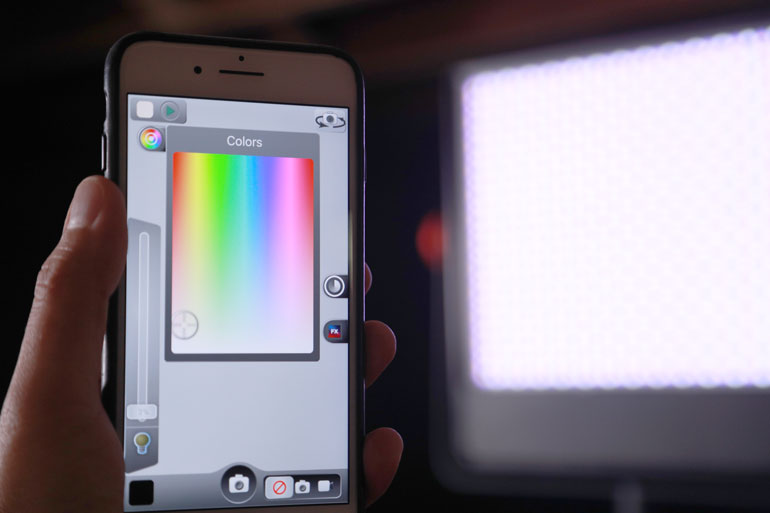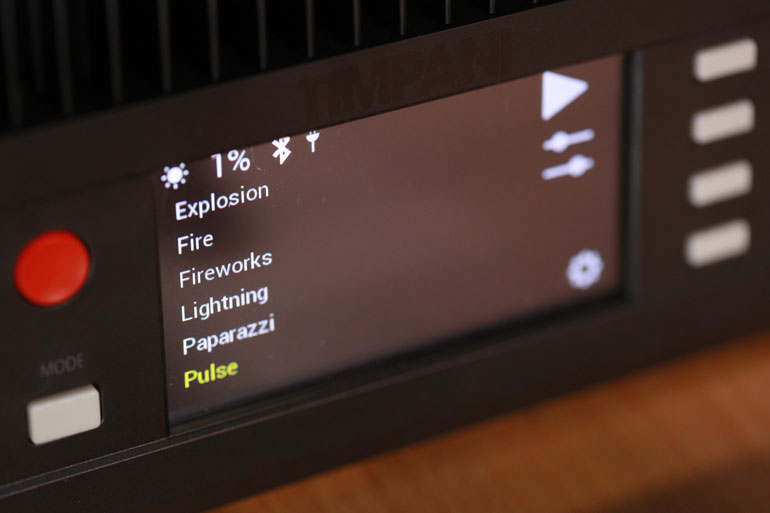Luxli Timpani RGB Light

An RGB light is one of those things where you can’t imagine why you’d want one, until you get one and then you can’t imagine not having one around.
Most everyday filmmakers haven’t had a chance to be won over by an RGB light, however, because the high costs of professional RGB lights prevent most owner operators from taking the plunge.
Luxli, however, is changing the game by introducing the Timpani 1x1 RGBAW LED Light, an innovative and feature rich, colorful light that’s very well designed, manufactured, and surprisingly affordably.
We recently wrote about RGB Lights in our review of the Luxli Cello RGB light. It’s such a brilliant and convenient little light, we feel it’s the perfect gateway drug to the world of RGB light fixtures. But once the Cello has you convinced, you’re inevitably going to want to up your game with more powerful RGB lights.
Thankfully, Luxli has you covered. The Timpani is the newest addition to Luxli’s Orchestra Series, which includes the 5-inch Viola and the 10-inch Cello. They all play well together, especially with Luxli’s companion app.
Together, the three Orchestra lights could even convince you to replace your current lighting kit, and jump completely into a world that has no color limitations.

Luxli Timpani Overview
Luxli is based in Norway, and all of their design and manufacturing is done in Norway. That’s part of what makes the Timpani attractive even before you learn about what it does.
The Timpani is a unique, well-built, Scandinavian-designed light fixture for under $1k, in a space where other professional color tunable lights like ARRI Skypanel and Litepanels Gemini go for 3-4x the price and are 3-4x the weight.

Here is a summary of the Timpani features:
672 RGBAW LED array, with each Phosphor LED composed of an Amber and White diode, plus an RGB circuit.
Color adjustable from 2,800 to 10,000K.
Saturation adjustment from 0-100%, which means in total it gives you over a trillion colors to choose from.
4100 lux output at 1 meter.
Color LCD display that shows one of three color selection modes, saturation, output level, special effects, and battery life.
RGB Color mode allows 1 degree rotation through the RGB color spectrum.
CCT Mode scrolls through Kelvin temperatures in 50K increments, from 2800K-10,000K.
Gel Filter Mode gives you 150 industry standard gels to chose from (this is a biggie - more on this below).
10 preprogrammed special effects for realistic lighting effects.
Bluetooth control with the Conductor mobile app, wireless range of 30 feet.
TLCI rating of 97+, CRI rating of 95 at most color temperatures.
Included removable yoke mount with tilt control and light stand mount.
Can be powered via V-mount battery or wall power through a 4-pin XLR input.
Lightweight aluminum housing, keeping total weight below 7 pounds.
Dimensions: 14.2 x 16.2 x 2.7 inches, including yoke.
DMX input/output via 5-pin XLR.
120 W power consumption.

The Timpani yoke is adjustable and also removable

Timpani Color Modes
The three built-in modes of color selection in the Timpani gives you an incredible amount of control over color, saturation, and output. There are also more color options with the bluetooth app, but we’ll get to that in a minute.
In RGB Color Mode, you have the entire visual spectrum available in the form of an RGB color wheel. Turning the physical knob gets you through all of the colors in 1 degree increments.

If you’re simply eyeballing the output, experimenting with colors and seeing what looks good for your scene, then the RGB mode is the easiest to start with. After you pick a color, you then move on to control the Saturation level from 0 to 100%, giving you more precision for just how much color you want to add to your shot.
The great thing about the saturation wheel is that reducing saturation does not reduce the light output, only the color intensity. In our experience using both the Timpani and the Cello, the Saturation adjustment is absolutely essential. In most cases you want to start with a little bit of color and then move up from there, giving yourself and your production crew time to adjust to the color.
That’s important because we’re all so used to daylight and tungsten colors on sets, that now when we’re beginning to add color to our medium, we need to ease in. If you were to suddenly point a bright pink light at your subject with 100% saturation, your crew might look at you a little strangely. Or maybe they’ll love it?
CCT Correlated Color Temperature Mode
In CCT Mode you can adjust the color by choosing a Kelvin temperature, going from 2800K to a whopping 10,000K, in 50K increments. You can also press in on the wheel to toggle between Daylight and Tungsten, which is nice for when you’re using the Timpani as a traditional bi-color fixture.
Gel Filter Mode
In the Gel Filter Mode, you can choose from 150 preset gels like 1/8 CTB and 1/4 Minus Green, on top of a customizable white balance. By giving users 150 of the industry’s most common gels to choose from, Luxli provides filmmakers with an alternative to needing to carry around gels at all.
The initial benefit of this is being able to use the Timpani to match other lights in your scene that have gels on them. Or maybe you’re accustomed to using gels to modify lights, and it’s easier for you to plan a scene with gel selection than by visualizing an RGB wheel.

But the other scenario where this mode is useful is if you want to match other lights to the Timpani. Say you’re using the Timpani as your key light, with a splash of color, and you want other secondary lights to match it. Here you would set 5600K as your base white point, and then scroll through the gels until you find a color you like, and then apply that physical gel to your other lights. Voila.
The last thing to say about gel filter mode is that our industry has standards that we must learn if we want to be helpful on set, and part of that is simply learning on the job. With a Luxli Timpani in your arsenal - for your personal and small crew productions - you can train yourself to work with industry standard gels that you maybe haven’t used before, a skill that will probably be very useful to you one day.
Luxli Timpani vs Alternatives
It’s difficult to compare the Timpani to other lights, since it doesn’t really fit into an established space yet. The Timpani is uniquely designed and also priced.
The ARRI Skypanel is perhaps the most similar in terms of color output, since it’s tunable from 2800K to 10,000K, and it has lots of other color selection modes as well.
But the ARRI Skypanel S60-C is also over $5700 and weighs over 26 pounds. So we’re not really talking about the same target market here. Most likely you’ll come across the Skypanel as a rented fixture rather than a part of your daily light kit.

The Litepanels Gemini is also a 2x1 that is becoming very popular for its versatility, and it's color adjustable from 2700K to 6000K.
Like the Luxli Timpani, the Gemini has a CCT mode, an HSI Color mode that enables hue selection and saturation/output adjustment, and also a Gel mode.
And, like the Timpani, the Gemini has lighting effects like TV simulation, strobes, fireworks, emergency lights, and so on.
The Gemini does have greater output - about 4300 lux at 1.5 meters, using up to 325 W of power consumption.
But it can only be powered via AC - or an Anton Bauer Cine battery that's 3x the price of the Timpani itself.
The Cine battery and the Gemini together weigh close to 50 pounds, and cost over $7,000.
So not exactly something most videographers can swallow for a purchase. Renting is more likely.
The Luxli Timpani, remember, is only about 7 pounds, and you can get a V-mount battery for a couple hundred bucks. The other nice thing is the battery plate on the Timpani is removable, so you if you're only using AC then the light can be slimmed up.

The Skypanels and Gemini are amazing lights and they will probably be industry workhorses for many years. However, most of us don’t have the means to use lights like these in our everyday corporate and documentary productions.
On the horizon is the Lupo Superpanel Full Colour 30, a new fixture that will also feature 2800-10,000K color wheel with RGBW technology. It’ll be similarly sized, along with a V-mount battery plate, and it will also have an HSI mode, CCT mode, and special effects. It certainly looks like a potential alternative choice for anyone who is considering a Timpani 1x1.
However, by the specs alone the Lupo consumes more power (200W) but has only 400 LEDs, with an output of 3800 lux at 1 meter. It’s not available in US stores yet, but current price for UK buyers is equivalent to about $1,600 US dollars.
Luxli Timpani vs traditional bicolor led panels
Of course, if you’re mostly interested in a new 1x1 fixture - but you’re not sure if you’re going to start using RGB colors just yet - then you have a ton of choices out there for reasonable bicolor 1x1 LED panels.

One light we have on hand is the Aputure Light Storm LS1C, which has 1536 LEDs, divided into tungsten and daylight bulbs. So at either end of the color spectrum, it uses 768 LEDs compared to the Timpani’s 672, and has an output of about 5000 lux at 1 meter. But that’s with a narrow 45 degree beam angle, compared to the Timpani’s wider 72 degree beam spread.
All together with the controller, the Light Storm LS1C weighs about 11.5 pounds, compared to the Timpani at about 7 pounds. So even if you don’t immediately see yourself using more than the standard daylight and tungsten outputs, the Timpani offers a competitive alternative to the Aputure LS1C.
There are plenty of other bicolor panels out there and we could do an apples to oranges comparison for any of them. But at the end of the day, the Luxli Timpani doesn’t really fit into an established market with similar lights at similar price points. It’s unique, and it demands a more careful look at all of its features, rather than a quick glance at its spec sheet.

The Timpani comes with a removable diffusion screen
Luxli Conductor App
The companion mobile app for the Timpani takes its feature set to another level. Not only can you control the light wirelessly at up to 30 feet, you can also choose a color by pointing your finger at precisely the color you want.
The app also features an Eyedropper Mode, which is an interesting approach to creative lighting. You can point the eyedropper to any picture on your device, and the Timpani will match that color.

Alternatively, you can also point the eyedropper at a video, and the Timpani will match the video as a lighting effect. For example, you can point the eyedropper at a video of a sunset, and the Timpani will match the color shift of the sunset over time. Show the app a video of a fireplace and it’ll mimic the fireplace colors and movement of colors over time.
Having remote control over an RGB light is so essential, more so than most lights, because you ought to be looking at your camera’s screen or a director’s monitor while adjusting the color and intensity of the Timpani. Also you probably should use a LUT on your monitor, so you can see the light’s color saturation and output with a finished look, rather than a flat image.

RGB lights are new for a lot of people, so we have to ease into learning how to use colors in our lighting arrangements. It’s a different world than simply walking into a room, looking around at the walls and lights, and deciding whether you should match the light with daylight, tungsten, or a mix of them to get a fluorescent kelvin temperature.
So, we think it may be a good idea to find an old tablet or smartphone, or buy a new one at the low end of features, just to use it as a dedicated remote for the Luxli Timpani. The app works for both iOS or Android, so you could get an Amazon Fire 7, a 7-inch Android based tablet, for under $50.
Luxli Orchestra Line
The advantage of Luxli’s Conductor app is that it can be paired with not only the Timpani, but the other RGB lights in Luxli’s Orchestra series. In fact, using all three of them as a kit makes a lot of sense, even if you don’t pair them to the app.

Below the Timpani is the Luxli Cello, which we recently reviewed.
It’s a 10-inch portable light that can be powered by a single Sony L-series battery. It has many of the same features as the Timpani but in a small package, with 176 LED diodes compared to Timpani’s 672.
We think the 10-inch Cello is a really good entry point into RGB lighting. Try it out on productions before deciding whether to invest fully in RGB.
And the smallest of the bunch, the Luxli Viola, is a 5-inch light intended to be used on-camera or for positioning around a scene, for pops of texture.
It has 88 LED diodes, but still outputs 600 lux at 1 meter, making it a pretty powerful light for the size.
The Viola was the first in the series, so it has been used and reviewed by more video shooters than either the Cello or Timpani. You may have even seen one out and about on a real world production.

Now, with all three of the Luxli Orchestra lights, you can design a 3-point lighting scheme with complete control over color, saturation, and output with the remote control Conductor app.
The Timpani could be used as a key light, the Cello is bright enough to be a fill, and the Viola can be placed behind the subject for use as a rim light.
For narrative and creative video shooters, you can combine all three into a special effects powerhouse that can turn ordinary sets into a living, breathing scenes.

Conclusion
The Luxli Timpani is a very interesting change in the RGB lighting space, because it's actually within reach for many video producers, both in affordability and portability. But it's not some cheap knockoff. The Norway-based company is attempting to design and manufacture very high end lights, but at aggressive price points.

An early sketch of the Luxli Viola
Included with every Timpani is a custom photometrics report, completed for that specific unit. That's really cool that Luxli takes that much pride in the Timpani's color accuracy that they give you a detailed report for the unit you've purchased.

If you're interested in learning more about its uses cases outside of narrative and creative filmmaking, we provide some demonstrations in our recent Luxli Cello review, all about RGB Lights in documentary and corporate filmmaking.
We look forward to seeing RGB lights being utilized by different types of video productions, now that more people can afford to dip into RGB lighting with the Luxli Timpani.
And we also look forward to seeing what Luxli has up its sleeve next!
Luxli Timpani 1x1 RGBAW LED Light - B&H Photo Video
